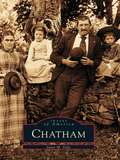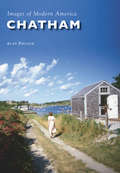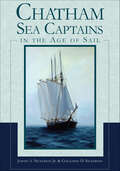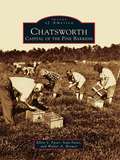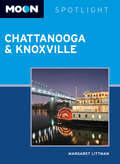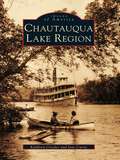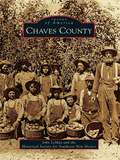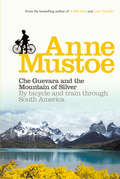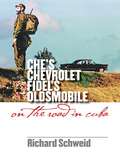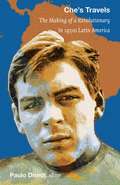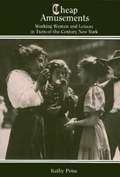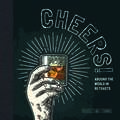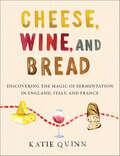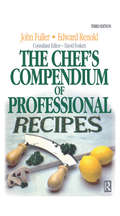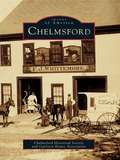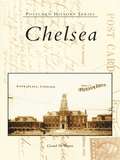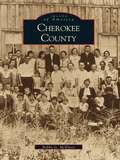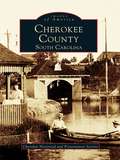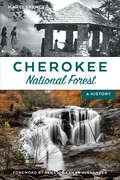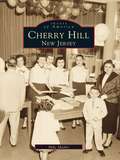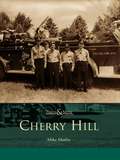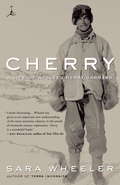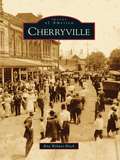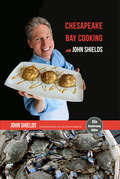- Table View
- List View
Chatham
by Janet M. DalyChatham is a historic Cape Cod town with coastline on Nantucket Sound and the Atlantic Ocean. The first European settler, William Nickerson, recognized its beauty and knew that farming and fishing would provide sustenance for future settlers. Chatham has many stories to tell-tales of boating and fishing, railroads and hotels, churches and theaters, shipwrecks and rescues, and wireless communication and war efforts. With vivid photographs, Chatham brings the town to life from the early 1800s to the 1960s. In these pages, see Chatham's lighthouse, which has warned of treacherous sandbars off the coast and has witnessed hundreds of shipwrecks since 1808, and the Mack Monument, which memorializes one valiant rescue. Visit the South Chatham Village Hall, which has rocked with laughter at Silver Circle entertainments; the Fourth of July parades; the 1912 and 1962 festivities celebrating Chatham's incorporation; and the weekly summer band concerts. Learn how technology changed Chatham from the arrival of the railroad and the building of the Marconi Wireless Station to the construction of the Chatham Naval Air Station, with its blimps and seaplanes protecting the East Coast from German submarines during World War I.
Chatham (Images of Modern America)
by Alan PollockIn 1987, the hungry Atlantic Ocean broke the barrier beach protecting Chatham, swallowing a handful of shorefront houses. But in the last half century, most of the change that has come to this town on the elbow of Cape Cod has been more subtle. Historic houses gave way to hotels when Chatham became an attractive vacation destination for motorists, and then the hotels became homes again as summer visitors sought to have a place of their own for retirement. Amid real estate booms, Chathamites struggled to keep the town's history and natural beauty from being erased. Treasures like the Godfrey gristmill, the Marconi wireless station, and even the Main Street School fell into disrepair but were later preserved. Chatham continues its wrestle with nature, confronting old challenges like erosion and new ones like water quality--and now great white sharks.
Chatham Sea Captains in the Age of Sail
by Geraldine D. Nickerson Joseph A. Nickerson Jr.Chatham Sea Captains in the Age of Sail chronicles the lives and adventures of twenty-five men who traveled the seas from the eighteenth through the twentieth century. These were extraordinary men�masters of navigation who charted paths from the Cape to the Far East with their regal clipper ships; deep-sea fishermen whose fearless spirit drove them to the Grand Banks and Newfoundland in the quest for their catch; and coastal captains who skirted America�s eastern seaboard in pursuit of trade. Spurred on by the Industrial Revolution�s demands, these mariners continued their pelagic exploration while pirates, privateers and Confederate raiders tested their mettle. The sea was both foe and ally. To meet the foe was the challenge; to sail her waters and return home as true masters was the force that drove these men to excellence.
Chatsworth: Capital of the Pine Barrens (Images of America)
by Ellen V. Fayer Stan Fayer Walter A. BrowerChatsworth, a small village in the New Jersey Pinelands, was known as Shamong until 1901. The community traces its beginning to the early 1700s, when settlers mined and forged bog iron to make cannonballs for the American Revolution, and farming was the primary source of income. In the mid-1800s, Chatsworth was a popular stopping point for stagecoach travelers to the Jersey Shore. The arrival of the railroad removed the remoteness of the village and captured the attention of people throughout the country. Prince Mario Ruspoli de Poggio-Suasa, an attaché of the Italian embassy in Washington, D.C., built an elegant villa at the lake. Soon after, the exquisite Chatsworth Country Club was built and counted among its membership a sitting vice president of the United States. It was during this period that Chatsworth played a dominant role in the development of the cranberry industry and began attracting hunters and others seeking recreational opportunities in the Pinelands. The cultivated blueberry industry also had its beginnings in Chatsworth in the 1930s.
Chattanooga & Knoxville
by Margaret Littman'Moon Spotlight Chattanooga & Knoxville' is a 76-page compact guide covering the best of these two Tennessee cities, including Lookout Mountain, Cherokee National Forest, and the East Tennessee History Center. Tennessee resident Margaret Littman offers her firsthand advice on must-see attractions, as well as maps with sightseeing highlights, so you can make the most of your time. This lightweight guide is packed with recommendations on entertainment, shopping, recreations, accommodations, food, and transportation, making navigating Chattanooga and Knoxville uncomplicated and enjoyable. This Spotlight guidebook is excerpted from 'Moon Tennessee. '
Chautauqua Lake Region (Images of America)
by Jane Currie Kathleen CrockerThe period from the late 1800s through the mid-1900s is fondly remembered as the heyday of the Chautauqua Lake region in southwestern New York State. It was a wondrous era, when railroads, steamboats, and trolleys transported local residents as well as wealthy and socially prominent families from Buffalo, Cleveland, Pittsburgh, Detroit, Cincinnati, and St. Louis to their summertime destinations around Chautauqua Lake.Showcased in Chautauqua Lake Region are not only adjacent lakeside communities, industries, and occupations of the residents but also the exceptional natural beauty of the lake itself, its importance to early navigation, its recreational attributes, and its overall allure as a tourist mecca. This "pocket museum" focuses on the myriad attractions that once dotted the lake's forty-two-mile shoreline: hotels, parks, camps, picnic groves, rowing clubs, boat liveries, fish hatcheries, icehouses, railroad and trolley depots, and steamboat landings.
Chaves County
by John Lemay Historical Society for Southeast New MexicoIn 1889, Roswell patriarch Capt. Joseph C. Lea, Pat Garrett (the former sheriff who shot Billy the Kid), and land developer Charles B. Eddy ventured to the territorial council and house in Santa Fe to petition for the creation of two new counties from the massive Lincoln County in southeastern New Mexico. The request was granted and Chaves County officially came into being on February 25, 1889. Today, 120 years later, Chaves County still thrives with a population of more than 60,000 people and is the dairy capital of the Southwest, producing around 1.7 billion pounds of milk annually. Explored in this volume is Chaves County's earliest peoples and settlements, including Roswell, Dexter, Hagerman, Lake Arthur, and Elk. It also takes a look at long-forgotten towns such as Acme, Blackdom, Cumberland, Greenfield and even old ranching outfits and farms such as John Chisum's South Spring River headquarters, the Clifton Chisholm alfalfa farm, and many others.
Che Guevara and the Mountain of Silver: By bicycle and train through South America
by Anne MustoeIn her brand-new travelogue, intrepid ex-headmistress and bestselling author Anne Mustoe dusts off the bicycle clips once more and embarks on a remarkable journey through South America. Following in the bike tracks of Che Guevara, Anne retraces the route this iconic revolutionary figure once tread, as documented in the famous Motorcycle Diaries. A second route takes her to Potosi, the highest city in the world, as she travels to the Mountain of Silver. Beautifully written and wonderfully evocative, Che Guevara and the Mountain of Silver charts an epic journey by bike and train through South America's most colourful and historically interesting areas.
Che's Chevrolet, Fidel's Oldsmobile
by Richard SchweidVintage U.S.-made cars on the streets of Havana provide a common representation of Cuba. Journalist Richard Schweid, who traveled throughout the island to research the story of motor vehicles in Cuba today and yesterday, gets behind the wheel and behind the stereotype in this colorful chronicle of cars, buses, and trucks. In his captivating, sometimes gritty, voice, Schweid blends previously untapped historical sources with his personal experiences, spinning a car-centered history of life on the island over the past century.Packard, Studebaker, Edsel, De Soto: cars long extinct in the United States can be seen at work every day on Cuba's streets. Havana and Santiago de Cuba today are home to some 60,000 North American cars, all dating back to at least 1959, the year the Cuban Revolution prevailed. Though hardly a new part has arrived in Cuba since 1960, the cars are still on the road, held together with mechanical ingenuity and willpower. Visiting car mechanics, tracking down records in dusty archives, and talking with car-crazy Cubans of all types, Schweid juxtaposes historic moments (Fidel Castro riding to the Bay of Pigs in an Oldsmobile) with the quotidian (a weary mother's two-cent bus ride home after a long day) and composes a rich, engaging picture of the Cuban people and their history. The narrative is complemented by fifty-two historic black-and-white photographs and eight color photographs by contemporary Cuban photographer Adalberto Roque.Vintage U.S.-made cars on the streets of Havana provide a common representation of Cuba. Journalist Richard Schweid, who traveled throughout the island to research the story of motor vehicles in Cuba today and yesterday, gets behind the wheel and behind the stereotype in this colorful chronicle of cars, buses, and trucks. In his captivating, sometimes gritty, voice, Schweid blends previously untapped historical sources with his personal experiences, spinning a car-centered history of life on the island over the past century. The narrative is complemented by fifty-two historic black-and-white photographs and eight color photographs by contemporary Cuban photographer Adalberto Roque.-->
Che's Travels: The Making of a Revolutionary in 1950s Latin America
by Paulo DrinotErnesto "Che" Guevara twice traveled across Latin America in the early 1950s. Based on his accounts of those trips (published in English as The Motorcycle Diaries and Back on the Road), as well as other historical sources, Che's Travels follows Guevara, country by country, from his native Argentina through Chile, Peru, Colombia, and Venezuela, and then from Argentina through Bolivia, Peru, Guatemala, and Mexico. Each essay is focused on a single country and written by an expert in its history. Taken together, the essays shed new light on Che's formative years by analyzing the distinctive societies, histories, politics, and cultures he encountered on these two trips, the ways they affected him, and the ways he represented them in his travelogues. In addition to offering new insights into Guevara, the essays provide a fresh perspective on Latin America's experience of the Cold War and the interplay of nationalism and anti-imperialism in the crucial but relatively understudied 1950s. Assessing Che's legacies in the countries he visited during the two journeys, the contributors examine how he is remembered or memorialized; how he is invoked for political, cultural, and religious purposes; and how perceptions of him affect ideas about the revolutions and counterrevolutions fought in Latin America from the 1960s through the 1980s. Contributors Malcolm Deas Paulo Drinot Eduardo Elena Judith Ewell Cindy Forster Patience A. Schell Eric Zolov Ann Zulawski
Cheap Amusements: Working Women and Leisure in Turn-of-the-Century New York
by Kathy PeissWhat did young, independent women do for fun and how did they pay their way into New York City's turn-of-the-century pleasure places? Cheap Amusements is a fascinating discussion of young working women whose meager wages often fell short of bare subsistence and rarely allowed for entertainment expenses. Kathy Peiss follows working women into saloons, dance halls, Coney Island amusement parks, social clubs, and nickelodeons to explore the culture of these young women between 1880 and 1920 as expressed in leisure activities. By examining the rituals and styles they adopted and placing that culture in the larger context of urban working-class life, she offers us a complex picture of the dynamics shaping a working woman's experience and consciousness at the turn-of-the-century. Not only does her analysis lead us to new insights into working-class culture, changing social relations between single men and women, and urban courtship, but it also gives us a fuller understanding of the cultural transformations that gave rise to the commercialization of leisure. The early twentieth century witnessed the emergence of "heterosocial companionship" as a dominant ideology of gender, affirming mixed-sex patterns of social interaction, in contrast to the nineteenth century's segregated spheres. Cheap Amusements argues that a crucial part of the "reorientation of American culture" originated from below, specifically in the subculture of working women to be found in urban dance halls and amusement resorts. Author note: Kathy Peiss author of Cheap Amusements: Working Women and Leisure in Turn-of-the-Century New York.
Cheers!: Around the World in 80 Toasts
by Brandon CookSalut! Prost! Skål! Na zdrave! Tagay! No matter what country you clink glasses in, everyone has a word for cheers. In Cheers! Around the World in 80 Toasts, Brandon Cook takes readers on a whirlwind trip through languages from Estonian to Elvish and everywhere in between. Need to know how to toast in Tagalog? Say "bottoms up" in Basque? "Down the hatch" in Hungarian? Cook teaches readers how to toast in 80 languages and includes drinking traditions, historical facts, and strange linguistic phenomena for each. Sweden, for instance, has a drinking song that taunts an uppity garden gnome, while Turkey brandishes words like Avrupalılaştıramadıklarımızdanmışsınızcasına. And the most valuable liquor brand in the world isn't Johnny Walker or Hennessey, but Maotai—President Nixon's liquor of choice when he visited China. Whether you're traveling the globe or the beer aisle, Cheers! will show you there's a world of fun waiting for you. So raise a glass and begin exploring!
Cheese, Wine, and Bread: Discovering the Magic of Fermentation in England, Italy, and France
by Katie Quinn“Open-hearted and buoyant, the book weaves together her hands-on experiences in Europe and introduces us to a rich cast of people who make, sell and care about these traditions.” —Jenny Linford, author of The Missing IngredientIn this delightful, full-color tour of France, England, and Italy, YouTube star Katie Quinn shares the stories and science behind everyone's fermented favorites—cheese, wine, and bread—along with classic recipes.Delicious staples of a great meal, bread, cheese, and wine develop their complex flavors through a process known as fermentation. Katie Quinn spent months as an apprentice with some of Europe’s most acclaimed experts to study the art and science of fermentation. Visiting grain fields, vineyards, and dairies, Katie brings the stories and science of these foods to the table, explains the process of each craft, and introduces the people behind them. What will keep readers glued to the book like a suspense novel is Katie's personal journey as an expat discovering herself abroad; Katie's vulnerability will turn readers into fans, and they'll finish the book feeling like they're her best friends, trusted with her innermost revelations.In England, Katie becomes a cheesemonger at Neal's Yard Dairy, London’s preeminent cheese shop—the beginning of a journey that takes her from a goat farm in rural Somerset to a nationwide search for innovating dairy gurus.In Italy, Katie offers an inside look at Italian winemaking with the Comellis at their family-owned vineyard in Northeast Italy and witnesses the diversity of vintners as she makes her way around Italy.In France, Katie meets the reigning queen of bread, Apollonia Poilâne of Paris' famed Poilâne Bakery, apprentices at boulangeries in Paris learning the ins and outs of sourdough, and travels the country to uncover the present and future of French bread.Part artisanal survey, part travelogue, and part cookbook, featuring watercolor illustrations and gorgeous photographs, Cheese, Wine, and Bread is an outstanding gastronomic tour for foodies, cooks, artisans, and armchair travelers alike.
Chef's Compendium of Professional Recipes
by David Foskett John Fuller Edward RenoldThis is a well-established reference and textbook for professional chefs and students. This edition presents essential recipes based on traditional and classic methods, but is simplified and adapted to meet the needs and conditions of the busy professional kitchen. Trends towards healthy and safe eating are taken into account and alternatives are suggested to certain ingredients to meet this demand. Vegetarian recipes are also included.
Chelmsford (Images of America)
by Chelmsford Historical Society Garrison House AssociationDiscover the history of Chelmsford, Massachusetts,from the 1800s to the present in this unprecedentedpictorial history. The collaborative efforts of the Chelmsford Historical Society and the Garrison House Association have made possible this timeless tribute to Chelmsford's past. Both groups are dedicated to the preservation of Chelmsford, and they present this collection as a legacy for future generations.Included in Chelmsford are the people, places, andlandmarks that have colored its history. View the early schools, churches, and civic organizations in the community as well as its industries, including Chelmsford Ginger Ale. Lone Pine, Pulpit Rock, and Beech Tree are among the landmarks pictured. The images in this collection remind us of a more traditional way of life in a simpler era in ournation's history. Step back in time with the Chelmsford Historical Society and the Garrison House Association in celebration of this community's past.
Chelsea (Postcard History)
by Gerard W. BrownUsing stereoviews and postcards, Chelsea chronicles ninety-five years of the city's glorious past as it emerged from agrarian roots to become an important industrial center and home for thousands of European immigrants. The pages are filled with more than one hundred eighty historic views, documenting Chelsea's history from the post-Civil War era to the Vietnam decade. Highlighted are the 1867 Water Celebration, the great fire of 1908, the city's rebirth during Reconstruction, the expansion of the Naval Hospital during World War I (today's Admirals Hill), Prattville, the Soldiers Home, the post-World War I era, and much more. This volume will excite anyone who is preservation minded and enjoys local history.
Chelsea Market Makers: Recipes, Tips, and Techniques from the Artisans of New York's Premier Food Hall
by Michael Phillips Cree LeFavourDiscover the secrets of New York&’s legendary Chelsea Market, with a behind-the-scenes look at its famous chefs, grocers, butchers, and cheese mongers. Fruit stands, fish mongers, doughnuts just out of the fryer—New York&’s Chelsea Market is a paradise of flavors, smells, sights, and sounds. With Chelsea Market Makers, Michael Phillips and Cree LeFavour take readers on a rare guided tour behind the stalls to dish with chefs, grocers, butchers, cheese mongers, and more about their methods, recipes, and expertise. You&’ll learn how to make a sourdough starter with Amy&’s Bread, artisanal cheese from Lucy&’s Whey, Mokbar&’s famous kimchi, and other delectable staples to fill the fridge and pantry. Organized alphabetically by subject, Chelsea Market Makers features more than seventy-five methods and recipes for signature market dishes, including Sarabeth&’s Rustic Apple Streusel Pie, Dickson&’s famous roast chicken, and unbelievable doughnuts from the Doughnuttery. With these tips, secrets, and recipes, you&’ll be ready to turn your own kitchen into an eclectic, irresistible culinary bazaar.
Cherokee County (Images of America)
by Bobby G. McelweeCreated in 1836 from land held formerly by the Cherokee Indians, Cherokee County is situated in the northeast corner of Alabama, bordered by Georgia to the east. Within these pages, the county's rich and varied history is illuminated by vintage photographs, and its past is brought to life in the faces of its early settlers. The families of the Reverend Whitefield Anthony and others settled at Mudd Creek in 1831 in what was to become Cherokee County. From these first families developed a community that would grow and change along with a young and bustling America, welcoming new industries, farming fertile lands, and building churches and schools to feed the hearts and minds of its young. The photographs in this volume, illustrating the county's past as well as how it looks in the present day, were culled from a variety of sources, including the Cherokee County History Museum, the Pine Grove Baptist Church, and the private collections of many local families. Coupled with a historical narrative, these glimpses of yesteryear will evoke fond memories for all who have made Cherokee County home.
Cherokee County, South Carolina (Images of America)
by Cherokee Historical and Preservation SocietySituated just south of the Carolina border in the scenic foothills of the Appalachian Mountains, Cherokee County offers the charm of small-town life and country living with the convenience of nearby metropolitan areas. In 1897, the year of its founding, the county inherited a rich history that began with the Cherokee Indians. Home to two American Revolutionary War sites, Cowpens National Battlefield and Kings Mountain Military Park, as well as the Overmountain Victory National Trail, it exists as a bevy of historical sites that date before the county was established.Cherokee County pays tribute to this community's decisive history and celebrates the local architecture, business establishments, and residents, both past and present. Historic views, coupled with informative text, highlight the 1914 Carnegie Library, the charming railroad depot, the Limestone Quarry, and construction of the towering smokestack of Gaffney Manufacturing Company. Vintage photographs depict downtown Gaffney, settled almost a century before Cherokee County became a political entity, and historic Blacksburg, known as Black Station before 1888, while bringing to life the evolution of the 1845 Limestone Springs Female High School into the state's popular Limestone College of today.
Cherokee National Forest: A History (Natural History)
by Marci SpencerExplore the sacred homeland of the Cherokee people Created in 1920, the 650,000-acre Cherokee National Forest lies north and south of the Great Smoky Mountains National Park. Located in the sacred homeland of the Cherokees, it pays tribute to its heritage in its name and protects ancient indigenous burial caves and portions of the Trail of Tears. By car, foot, horse, or watercraft, visitors explore the natural beauties of the region, such as the Roan, Max Patch, Unicoi, and Unaka mountains and the Ocoee, Hiwassee, Nolichucky, Watauga, and French Broad rivers. The Appalachian, Benton MacKaye, and John Muir trails and other pathways lead to mountain-top views, rock cliffs, forested coves and gardens of abundant wildflowers. Local author Marci Spencer tells the stories of these wonders and the early settlers, railroad workers, loggers and miners who lived and worked among them.
Cherry Hill, New Jersey
by Mike MathisUntil 1961, Cherry Hill was known as Delaware Township. From its inception in 1844, Delaware Township was an agrarian community dotted with gristmills, blacksmith shops, and taverns. Many farmers earned their livings by selling produce tothe Campbell's Soup Company, which had its canning plant in Camden until the 1980s. Delaware Township remained relatively quiet until the 1920s, when the first residential building boom resulted in neighborhoods such as Colwick, Erlton, Woodland, and Barlow. It was changed forever in 1942, when Vinelandbusinessman Eugene Mori opened the Garden State Park racetrack, which became a popular destination for war-weary workers. Mori also opened the Cherry Hill Inn in 1954. The old Cherry Hill Farm and its brilliant cherry trees would inspire the township'sresidents to change their community's name to Cherry Hill seven years later. Cherry Hill, New Jersey captures the growth of this charming suburban community from the early 20th century through the 1990s. See local landmarks that have long since vanished, such as the Latin Casino, the Cherry Hill Inn, the original Garden State Park, and the Cherry Hill Arena, as well as old farmsteads, street scenes, and the people that helped shape the community.
Cherry Hill: New Jersey (Then and Now)
by Mike MathisLong before shopping centers and housing communities were developed in Cherry Hill, farmers earned their livelihood working the rich soil that stretched between the Cooper River and Pennsauken Creek. Small hamlets such as Ellisburg, Colestown, and Batesville contained thriving businesses. A real estate boom triggered by the opening of the Delaware River Bridge (now the Ben Franklin Bridge) and the end of World War II led to the development of the township's first suburban neighborhoods. New homes, hotels, nightclubs, corporate parks, and one of the nation's first shopping malls appeared where tomatoes, peaches, and corn had grown just a few years earlier.Then & Now: Cherry Hill documents the monumental changes that have occurred in South Jersey's largest suburban municipality over the last 100 years. This book reflects on a time when Chapel Avenue was a dirt lane, when the children of farmers were educated in one-room schoolhouses, when cows grazed on the grounds of the present Cherry Hill Mall, and when stately old houses dominated the rural landscape. Then & Now: Cherry Hill also features long-gone attractions such as the Latin Casino, the Camden County Music Fair, the original Garden State Park, Cinelli's, the Hawaiian Cottage, and the Rustic Inn.
Cherry: A Life of Apsley Cherry-Gerrard
by Sara WheelerThe first authorized biography of the antarctic explorer who gave us the greatest classic of polar literature. In February 1912, Apsley Cherry-Garrard drove a team of dogs 150 miles to a desolate outpost on Antarctica's rough ice shelf to meet Robert Falcon Scott and his men, who were expected to return victorious any day from their epic race to the South Pole. Winter was closing in, and Cherry was handicapped by brutal temperatures and diminishing light. Less than two weeks later, three dying men pitched their tent for the last time just twelve miles to the south. One was Captain Scott, the leader of the expedition. The other two, Birdie Bowers and Bill Wilson, were the closest friends Cherry had ever had. Ten months later, once the polar winter had released them from captivity, Cherry and his search party found the tent, piled with snow and pinned to the ice by his friends' corpses. It was a tragedy that would rever-berate around the world and inspire Cherry to write his masterpiece,The Worst Journey in the World, which recently toppedNational Geographic's list of the 100 greatest adventure books of all time. Cherry discovered in his writing a means to work out his grief and anger, but in life these doubts and fears proved far harder to quell. As the years progressed, he struggled against depression, breakdown, and despair, and was haunted by the possibility that he alone had had the opportunity to save Scott and his friends. Sara Wheeler'sCherryis the first biography of this soul-searching explorer, written with unrestricted access to his papers and the full cooperation of his widow -- who has refused all requests until now. Wheeler's biography brings to life this great hero of Antarctic exploration and gives us a glimpse of the terrible human cost of his adventures.
Cherryville
by Rita Wehunt-BlackCherryville, originally called White Pine, was renamed for the cherry trees lining the Old Post Road leading into town. It is located in the rolling hills of the Carolina Piedmont. The village was spun from the wilderness during the mid-1700s, when Scots-Irish and German immigrants settled the area around Beaver Dam and Indian Creeks. These settlers brought with them their languages, religions, music, and customs. The German tradition of shooting in the New Year with muskets and black powder continues today after 250 years. The area was a hotbed of Tory activity during the Revolutionary War, with Col. John Moore, the notorious Tory who was defeated at the Battle of Ramseur's Mill, living on Indian Creek. With the advent of the railroad in the 1860s, the first cotton mill in 1891, and the international firm of Carolina Freight Carriers Corporation in 1932, Cherryville has grown into a sophisticated, modern town.
Chesapeake Bay Cooking with John Shields
by John. ShieldsDiscover the cuisine and the character of the Chesapeake Bay with the twenty-fifth-anniversary edition of this collection of over 200 regional, seasonal recipes.Twenty-five years ago, Chesapeake Bay Cooking with John Shields introduced the world to the regional cuisine of the Mid-Atlantic. Nominated for a James Beard Award, the book was praised for its inspiring heritage recipes and its then-revolutionary emphasis on cooking with local and seasonal ingredients. Part history lesson, part travelogue, the book captured the unique character of the Chesapeake region and its people.In this anniversary edition, John Shields combines popular classic dishes with a host of unpublished recipes from his personal archives. Readers will learn how to prepare over 200 recipes from the Mid-Atlantic region, including panfried rockfish, roast mallard, beaten biscuits, oyster fritters, and Lady Baltimore cake. Best of all, they’ll learn everything they need to know about crabs?the undisputed star of Chesapeake cuisine?featured here in mouthwatering recipes for seven different kinds of crab cakes.Extensively updated, this edition includes a new chapter on Chesapeake libations, which features Shields’s closely held recipe for his notorious Dirty Gertie, an authentic Chesapeake-style Bloody Mary.“Long before it was trendy to serve sustainable, local, and organic food, Maryland native Shields was doing it at Gertrude’s, a modest modern restaurant tucked inside the Baltimore Museum of Art. This fall he reissued his prescient chronicle of the waterman’s way of life and traditional cooking on the mid-Atlantic coast. It includes how to “pick” steamed crabs (seasoned with Old Bay, natch), prepare country sides like Green Beans With Country Ham and Sautéed Peanuts, and make the quirky relish known as chow-chow.” —April Fulton, National Geographic’sfood blog, The Plate“John knows and loves the Chesapeake as only a native can. One of the best regional American cookbooks you’ll ever find.” —Gourmet“For those who are not familiar with the “good old down home” taste of cooking by a native of the Chesapeake Bay region, John Shields brings you an experience you'll never forget. For those of us who are fortunate enough to be a part of this region, Mr. Shields reminds us of the experience we’ll always remember.” —The Honorable William Donald Schaefer, former governor of Maryland
